独立主格结构用法
独立主格结构的用法

独立主格结构的用法独立主格结构是一个名词或代词(作为逻辑主语),加上一个形容词、副词、介词短语、分词、不定式、名词等构成,在句中常作状语。
一、独立主格结构的特点1、独立主格结构的逻辑主语与句子主语不同,它独立存在。
2、名词或代词与后面的形容词、副词、介词短语、分词、不定式等存在逻辑上的主谓关系。
3、独立主格结构一般是用逗号与主句分开,但与主句之间不能使用任何连接词。
二、独立主格结构的构成1、名词或代词 + 现在分词The children playing in the room, I couldn’t get down studying.孩子们在屋里玩,我没法学习。
Mother being ill, I had to stay at home looking after her.母亲病了,我只好待在家里照顾她。
There being no bus, we had to walk home.由于没有公共汽车,我们只好走回家。
2、名词或代词 + 过去分词Five years later, he returned home, his character greatly changed.五年后他返回家乡,性格大变了。
They walked along holding hands, their fingers interlocked.他们手指交错,携手而行。
The job finished, we went home.工作结束后我们就回家了。
Everything considered, his plan seems better.从各方面考虑,他的计划似乎好一些。
That done, he put on his sweater and went out.做完这事他穿上毛衣出去了。
The question settled, they went back to their respective posts.问题解决了,他们就各自回到了他们的工作岗位。
独立主格结构的用法说明与注意点
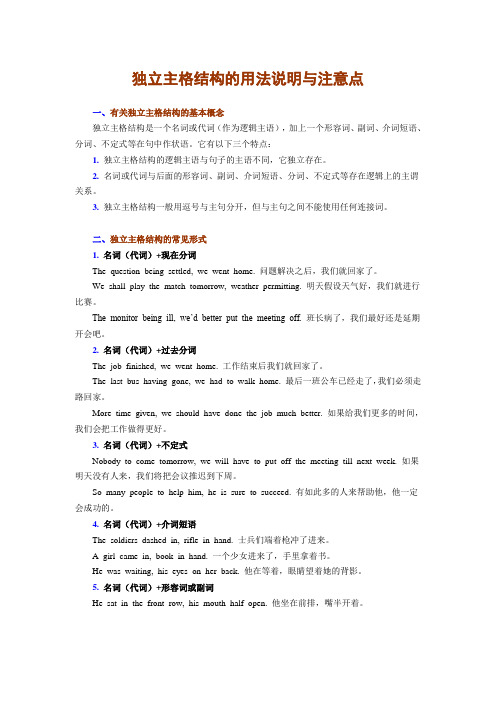
独立主格结构的用法说明与注意点一、有关独立主格结构的基本概念独立主格结构是一个名词或代词(作为逻辑主语),加上一个形容词、副词、介词短语、分词、不定式等在句中作状语。
它有以下三个特点:1.独立主格结构的逻辑主语与句子的主语不同,它独立存在。
2.名词或代词与后面的形容词、副词、介词短语、分词、不定式等存在逻辑上的主谓关系。
3.独立主格结构一般用逗号与主句分开,但与主句之间不能使用任何连接词。
二、独立主格结构的常见形式1.名词(代词)+现在分词The question being settled, we went home. 问题解决之后,我们就回家了。
We shall play the match tomorrow, weather permitting. 明天假设天气好,我们就进行比赛。
The monitor being ill, we’d better put the meeting off. 班长病了,我们最好还是延期开会吧。
2.名词(代词)+过去分词The job finished, we went home. 工作结束后我们就回家了。
The last bus having gone, we had to walk home. 最后一班公车已经走了,我们必须走路回家。
More time given, we should have done the job much better. 如果给我们更多的时间,我们会把工作做得更好。
3.名词(代词)+不定式Nobody to come tomorrow, we will have to put off the meeting till next week. 如果明天没有人来,我们将把会议推迟到下周。
So many people to help him, he is sure to succeed. 有如此多的人来帮助他,他一定会成功的。
4. 名词(代词)+介词短语The soldiers dashed in, rifle in hand. 士兵们端着枪冲了进来。
语法解析独立主格的用法和例子
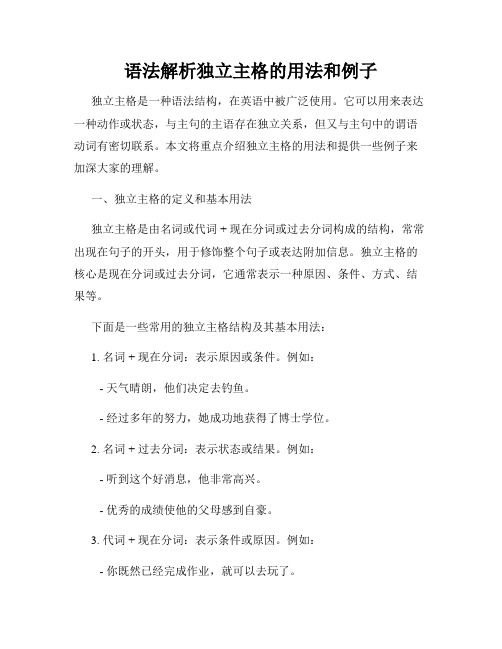
语法解析独立主格的用法和例子独立主格是一种语法结构,在英语中被广泛使用。
它可以用来表达一种动作或状态,与主句的主语存在独立关系,但又与主句中的谓语动词有密切联系。
本文将重点介绍独立主格的用法和提供一些例子来加深大家的理解。
一、独立主格的定义和基本用法独立主格是由名词或代词 + 现在分词或过去分词构成的结构,常常出现在句子的开头,用于修饰整个句子或表达附加信息。
独立主格的核心是现在分词或过去分词,它通常表示一种原因、条件、方式、结果等。
下面是一些常用的独立主格结构及其基本用法:1. 名词 + 现在分词:表示原因或条件。
例如:- 天气晴朗,他们决定去钓鱼。
- 经过多年的努力,她成功地获得了博士学位。
2. 名词 + 过去分词:表示状态或结果。
例如:- 听到这个好消息,他非常高兴。
- 优秀的成绩使他的父母感到自豪。
3. 代词 + 现在分词:表示条件或原因。
例如:- 你既然已经完成作业,就可以去玩了。
- 她一直工作到很晚,她是个勤奋的人。
4. 代词 + 过去分词:表示结果或状态。
例如:- 你们回报的消息让我惊讶不已。
- 感谢大家的帮助,我们取得了很好的成绩。
二、独立主格的例子和解析以下是一些具体的例子,以帮助大家更好地理解独立主格的用法和构造。
1. The children finished their homework, their faces beaming with joy.在这个例子中,独立主格结构 "their faces beaming with joy" 表示结果,表示孩子们完成作业的结果是他们脸上洋溢着喜悦的表情。
2. The teacher explained the grammar rules, her voice filled with enthusiasm.在这个例子中,独立主格结构 "her voice filled with enthusiasm" 表示状态,表示老师解释语法规则时声音充满了热情。
独立主格结构用法全解

独立主格结构用法全解独立主格结构是英语语法中的一种特殊句式,用以表达两个同时进行的动作或事件,其中一个动作或事件与句子的主语没有动宾关系。
独立主格结构通常由一个名词或代词作为独立主格,加上一个现在分词或过去分词构成。
本文将详细介绍独立主格结构的用法及相关注意事项。
常见的独立主格结构包括现在分词的独立主格结构和过去分词的独立主格结构。
1.现在分词的独立主格结构现在分词的独立主格结构用于表达两个同时进行的动作或事件,其中一个动作与主语无动宾关系。
例句:- The weather being fine, we went for a picnic. (天气很好,我们去野餐了。
)- The car having broken down, we had to walk home. (车子抛锚了,我们不得不走回家。
)2.过去分词的独立主格结构过去分词的独立主格结构用于表达两个同时进行的动作或事件,其中一个动作与主语无动宾关系。
例句:- The work finished, we went out for dinner. (工作完成后,我们出去吃饭。
)- The books borrowed from the library, he started studying for his exams. (从图书馆借来的书,他开始为考试复习。
)1.独立主格结构的独立主格通常是一个名词或代词,但也可以是其他形式的词组,如不定式短语或从句。
例句:- Her son being sick, she couldn't go to work. (她的儿子生病了,她不能去上班。
)- The professor having arrived, the lecture began. (教授到达后,讲座开始了。
)2.独立主格结构与主句之间应该有逗号隔开,表示两个独立的动作或事件。
例句:- The sun shining brightly, we decided to go for a walk. (阳光明媚,我们决定去散步。
高中英语语法 独立主格结构用法全解(含答案)

独立主格结构独立主格结构(Absolute Structure)是由名词或代词加上分词等构成的一种独立结构,用于修饰整个句子。
独立主格结构中的名词或代词与其后的分词等构成逻辑上的主谓关系。
这种结构与主句不发生句法上的联系,它的位置相当灵活,可置于主句前、主句末或主句中,常由逗号将其与主句分开。
需特别注意的是,独立主格结构与主句之间不能使用任何连接词。
二、独立主格结构基本构成形式名词(代词)+现在分词(过去分词;形容词;副词;不定式;名词;介词短语)1. 名词(代词)+现在分词Night enshrouding the earth, nobody could make out what the dark mass was from a distance.黑夜笼罩大地,谁也看不清远处黑压压的一片是什么东西。
There being no bus, we had to walk home.由于没有公共汽车,我们只好走回家。
2. 名词(代词)+过去分词The workers worked still harder, their living conditions greatly improved.由于工人们的生活条件大大提高,他们工作得更起劲了。
He was listening attentively in class, his eyes fixed on the blackboard.他上课专心听讲,眼睛紧盯着黑板。
3. 名词(代词)+不定式在“名词/代词+动词不定式”结构中,动词不定式和它前面的名词或代词如果存在着逻辑上的主谓关系,动词不定式则用主动的形式;如果是动宾关系,则用被动形式。
The four of us agreed on a division of labor, each to translate a quarter of the book.我们四人同意分工干,每人翻译全书的四分之一。
Many trees, flowers, and grass to be planted, our newly-built school will look even more beautiful.种上许多的树、花和草后,我们新建的学校看上去将更美。
独立主格用法详解
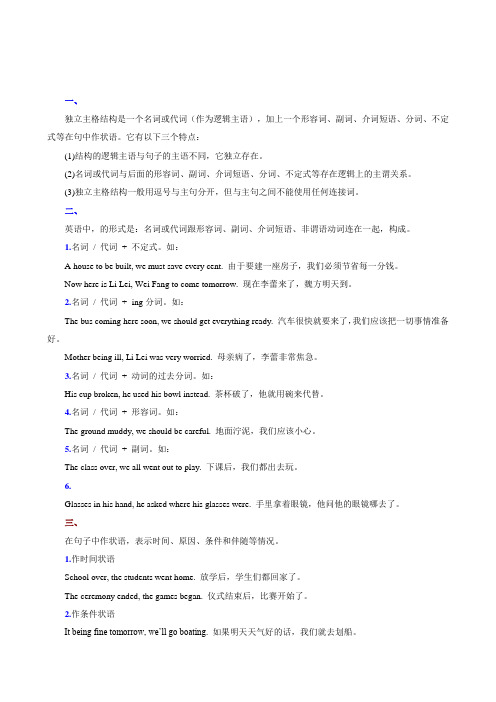
一、独立主格结构是一个名词或代词(作为逻辑主语),加上一个形容词、副词、介词短语、分词、不定式等在句中作状语。
它有以下三个特点:(1)结构的逻辑主语与句子的主语不同,它独立存在。
(2)名词或代词与后面的形容词、副词、介词短语、分词、不定式等存在逻辑上的主谓关系。
(3)独立主格结构一般用逗号与主句分开,但与主句之间不能使用任何连接词。
二、英语中,的形式是:名词或代词跟形容词、副词、介词短语、非谓语动词连在一起,构成。
1.名词/ 代词+ 不定式。
如:A house to be built, we must save every cent. 由于要建一座房子,我们必须节省每一分钱。
Now here is Li Lei, Wei Fang to come tomorrow. 现在李蕾来了,魏方明天到。
2.名词/ 代词+ -ing分词。
如:The bus coming here soon, we should get everything ready. 汽车很快就要来了,我们应该把一切事情准备好。
Mother being ill, Li Lei was very worried. 母亲病了,李蕾非常焦急。
3.名词/ 代词+ 动词的过去分词。
如:His cup broken, he used his bowl instead. 茶杯破了,他就用碗来代替。
4.名词/ 代词+ 形容词。
如:The ground muddy, we should be careful. 地面泞泥,我们应该小心。
5.名词/ 代词+ 副词。
如:The class over, we all went out to play. 下课后,我们都出去玩。
6.Glasses in his hand, he asked where his glasses were. 手里拿着眼镜,他问他的眼镜哪去了。
三、在句子中作状语,表示时间、原因、条件和伴随等情况。
英语独立主格结构的用法

学法新探独立主格结构,紧凑简练,是由名词或代词作为逻辑主语,分词、不定式、形容词、副词及介词短语等作为逻辑谓语构成,可以表示时间、原因、条件、方式、伴随、目的等情况,主要用作状语,修饰整个句子,与主句之间不用任何连接词,而是多用逗号隔开。
它是高中英语中至关重要的语法知识之一,也是高考英语的一大考查热点。
一、独立主格结构的构成形式(1)名词/代词+分词。
名词或代词加分词可以构成独立主格结构,其中的现在分词表示主动或正在进行的动作,名词或代词表示动作的执行者,它与现在分词构成逻辑上的主谓关系;而过去分词则表示被动或已完成的动作,名词或代词表示动作的承受者,它与过去分词构成逻辑上的动宾关系或系表结构。
如:①Many eyes watching him,he felt a bit nervous.(许多双眼睛看着他,他感到有点紧张。
)②The experimentfinished,the students jumped up happily.(实验完成了,学生们开心地跳了起来。
)(2)名词/代词+动词不定式。
名词或代词加动词不定式可以构成独立主格结构,其中不定式表示逻辑主语将要发出的动作,如果动作与逻辑主语存在主谓关系,则用主动形式;若为动宾关系,则用被动形式。
如:①Many trees,flowers,and grass to be planted,ournewly-built school will look even more beautiful.(被动形式,种上许多的树、花和草后,我们新建的学校看上去将更美。
)②The last guest to arrive,our party wasstarted.(主动形式,最后一位客人一到,我们的晚会就开始。
)(3)名词/代词+形容词/副词。
名词或代词加形容词或副词可以构成独立主格结构,其中形容词主要表示逻辑主语的性质和特征;副词则表示逻辑主语所处的状态。
独立主格结构及其用法
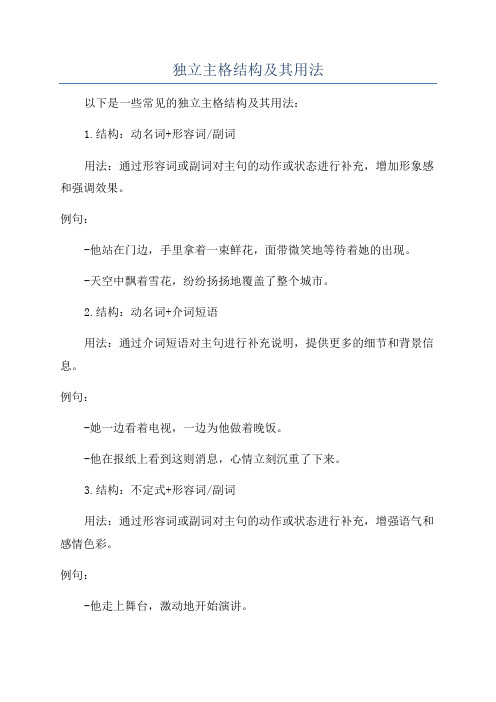
独立主格结构及其用法以下是一些常见的独立主格结构及其用法:1.结构:动名词+形容词/副词用法:通过形容词或副词对主句的动作或状态进行补充,增加形象感和强调效果。
例句:-他站在门边,手里拿着一束鲜花,面带微笑地等待着她的出现。
-天空中飘着雪花,纷纷扬扬地覆盖了整个城市。
2.结构:动名词+介词短语用法:通过介词短语对主句进行补充说明,提供更多的细节和背景信息。
例句:-她一边看着电视,一边为他做着晚饭。
-他在报纸上看到这则消息,心情立刻沉重了下来。
3.结构:不定式+形容词/副词用法:通过形容词或副词对主句的动作或状态进行补充,增强语气和感情色彩。
例句:-他走上舞台,激动地开始演讲。
-她努力学习,渴望着取得好成绩。
4.结构:不定式+介词短语用法:通过介词短语对主句进行补充说明,提供更多的细节和背景信息。
例句:-为了参加比赛,他每天都早早起床训练。
-为了庆祝生日,我们决定一起去旅行。
5.结构:动名词/不定式+从句用法:通过从句对主句进行补充说明,起到进一步解释的作用。
例句:-坐在树下,她细细品味着书中的每个字句。
-发现了问题,他立刻采取了解决措施。
6.结构:连词+动名词/不定式用法:通过连词引导的短语对主句进行补充说明或转折关系。
例句:-虽然她很累,她仍然坚持继续工作。
-他犹豫了一下,然后决定放弃。
1.避免重复主语。
独立主格结构提供的补充信息应该和主句的主语不重复,而是提供额外的信息。
2.注意句子结构的平衡。
独立主格结构应该和主句之间保持平衡,使句子结构更加完整和清晰。
3.注意时态和语态的一致。
独立主格结构的动词必须和主句的时态和语态保持一致,以确保句子的逻辑和语法正确。
4.注意使用适当的连词。
在使用连词引导独立主格结构时,要根据句子的意思选择适当的连词,以表达出正确的语义关系。
总之,独立主格结构是一种常用的语言表达方式,在句子中起到补充的作用,使句子更加丰满和生动。
通过正确运用独立主格结构,可以提高语言表达的能力和效果。
独立主格结构的构成和用法
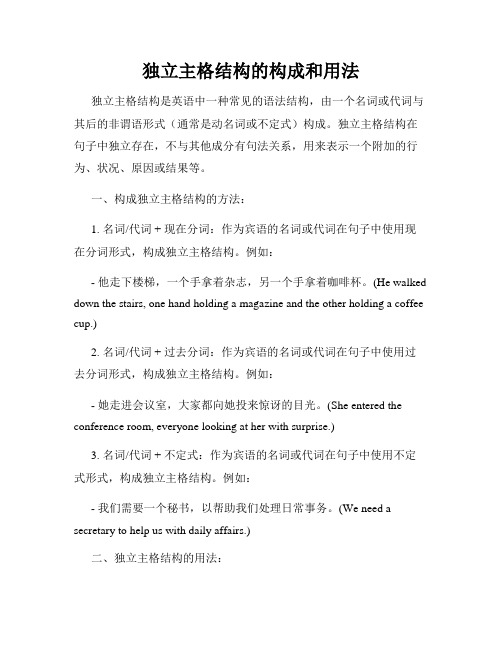
独立主格结构的构成和用法独立主格结构是英语中一种常见的语法结构,由一个名词或代词与其后的非谓语形式(通常是动名词或不定式)构成。
独立主格结构在句子中独立存在,不与其他成分有句法关系,用来表示一个附加的行为、状况、原因或结果等。
一、构成独立主格结构的方法:1. 名词/代词 + 现在分词:作为宾语的名词或代词在句子中使用现在分词形式,构成独立主格结构。
例如:- 他走下楼梯,一个手拿着杂志,另一个手拿着咖啡杯。
(He walked down the stairs, one hand holding a magazine and the other holding a coffee cup.)2. 名词/代词 + 过去分词:作为宾语的名词或代词在句子中使用过去分词形式,构成独立主格结构。
例如:- 她走进会议室,大家都向她投来惊讶的目光。
(She entered the conference room, everyone looking at her with surprise.)3. 名词/代词 + 不定式:作为宾语的名词或代词在句子中使用不定式形式,构成独立主格结构。
例如:- 我们需要一个秘书,以帮助我们处理日常事务。
(We need a secretary to help us with daily affairs.)二、独立主格结构的用法:1. 表示方式或行为:独立主格结构可以用来描述人们在某种行为中的方式或方式。
例如:- 他站在窗前,双手紧握着一本书,专注地阅读。
(He stood by the window, hands tightly holding a book, reading attentively.)2. 表示原因或条件:独立主格结构可以用来表示一个行为或条件对句子的原因或条件。
例如:- 天气太冷了,我们不得不把花木挪到室内过冬。
(The weather was too cold, so we had to move the plants indoors for winter.)3. 表示结果或影响:独立主格结构可以用来表示一个行为或条件对句子的结果或影响。
独立主格的用法

独立主格结构独立主格结构在句中往往做状语,表时间、原因、条件、方式或伴随状况。
【注意】独立主格结构表示时间、条件或原因时,相当于一个状语从句,一般放在句首,表示原因时还可放在句末;表伴随状况或补充说明时,相当于一个并列句,通常放于句末。
独立主格的用法:1.表时间,相当于一个时间状语从句The meal over, we began to work again.(=When the meal was over,we began to work again.)吃晚饭,我们又开始工作。
The homework done, Jim decided to go and see the play.(=After the homework was done, Jim decided to go and see the play.)作业做完后,Jim决定去看戏。
2.表原因,相当一个于原因状语从句Her shirt caught on a nail, she could not move.(=Because her shirt was caught on a nail,…)由于他的衬衫挂在钉子上了,所以她动不了。
The window broken, the cold wind blew into the room.(=Because the window was broken, …)由于窗户坏了,冷风吹进了这间房。
3.表条件,相当于一个条件状语从句Weather permitting, the football match will played on Wednesday.(=If weather permits, …)如果天气允许,足球比赛将在周三举行。
The book written in simple English, it will be more popular.(=If the book is written in simple English, …)如果这本书用简易英语写的,它会更畅销。
独立主格用法详解

独立主格用法详解一、独立主格结构的特点独立主格结构是一个名词或代词(作为逻辑主语),加上一个形容词、副词、介词短语、分词、不定式等在句中作状语。
它有以下三个特点:(1) 独立主格结构的逻辑主语与句子的主语不同,它独立存在。
(2) 名词或代词与后面的形容词、副词、介词短语、分词、不定式等存在逻辑上的主谓关系。
(3) 独立主格结构一般用逗号与主句分开,但与主句之间不能使用任何连接词。
二、独立主格结构的形式英语中,独立主格结构的形式是:名词或代词跟形容词、副词、介词短语、非谓语动词连在一起,构成独立主格结构。
1.名词/ 代词+ 不定式。
如:A house to be built, we must save every cent. 由于要建一座房子,我们必须节省每一分钱。
Now here is Li Lei, Wei Fang to come tomorrow. 现在李蕾来了,魏方明天到。
2.名词/ 代词+ -ing分词。
如:The bus coming here soon, we should get everything ready. 汽车很快就要来了,我们应该把一切事情准备好。
Mother being ill, Li Lei was very worried. 母亲病了,李蕾非常焦急。
3.名词/ 代词+ 动词的过去分词。
如:His cup broken, he used his bowl instead. 茶杯破了,他就用碗来代替。
4.名词/ 代词+ 形容词。
如:The ground muddy, we should be careful. 地面泞泥,我们应该小心。
5.名词/ 代词+ 副词。
如:The class over, we all went out to play. 下课后,我们都出去玩。
6.名词/ 代词+ 介词短语。
如(from ):Glasses in his hand, he asked where his glasses were. 手里拿着眼镜,他问他的眼镜哪去了。
独立主格结构的用法总结

独立主格结构的用法总结推荐文章not…but的用法总结热度:remain的意思和用法总结热度:afraid的用法归纳总结热度: hard的同义词英文热度: compare用法总结精讲热度:以下是小编为大家整理的独立主格结构的用法,希望能帮助大家更好地认识独立主格结构,提高英语水平。
一、独立主格结构的含义和实质“独立主格结构”(absolute construction)又叫“独立结构”,是带有自己主语的非谓语动词分句和无动词分句。
由于在语法上有自己的逻辑主语,结构上与主句不发生关系,因此传统语法叫做“独立主格结构”。
其实,所谓“独立主格结构”并非真正独立,它还是一种从属分句,与主句紧密联系在一起,共同表达一个完整的意思,通常在句中起状语分句的作用。
独立主格结构可放于句首、句尾,用逗号和主句隔开。
二、独立主格结构的基本形式和功能独立主格结构可以分为两部分:一部分是名词或代词,起逻辑主语的作用;另一部分是非谓语动词分句(现在分词、过去分词、不定式)或无动词分句(名词、形容词、副词、介词短语),表示前面名词或代词的动作或状态。
基本形式是:名词普通格/代词主格+现在分词/过去分词/不定式/名词/形容词/副词/介词短语,with引导的复合结构。
1. 名词/代词+ 现在分词现在分词表示前面的名词或代词主动进行的动作或状态等。
例His homework having been done, Tom went to sleep.So many students being absent, the meeting had to be put off.The man lay there, his hands trembling.注:“独立结构”中的being或 having been 有时可以省去,这样就成了无动词分句或过去分词分句。
2. 名词/代词+过去分词过去分词表示前面的名词或代词被动完成的动作或所处的一种状态。
独立主格结构用法归纳

独立主格结构用法归纳独立主格结构是英语语法中的一种特殊结构,它由一个名词(或代词)和一个动词的动名词形式构成,常常用来表达并列、原因、条件、时间等关系,使句子更加丰富和灵活。
本文将归纳总结独立主格结构的常见用法。
1. 表示时间关系独立主格结构可以用来表示几个动作同时进行或先后发生的时间关系。
例如:- The sun having set, we decided to have dinner.- The meeting being over, she left the room.2. 表示原因或理由独立主格结构可以用来表达一个行为或状态的原因或理由。
例如:- The weather being fine, we decided to go for a picnic.- The book being interesting, I couldn't put it down.3. 表示条件关系独立主格结构常用来表示一个条件或假设,进一步说明主句中的动作。
例如:- The work being finished, we can go home now.- The road being icy, drivers should be careful.4. 表示逻辑关系独立主格结构还可以用来表达一个逻辑关系,使句子的意思更加明确。
例如:- The problem being solved, we can move on to the next task.- The question being raised, we need to find a solution.5. 表示让步关系独立主格结构有时可以表达一个让步关系,表示尽管存在某种情况,但结果仍然如此。
例如:- The car being old, it still runs very smoothly.- The child being young, he could solve the math problem.需要注意的是,独立主格结构通常放在句首,与主句之间用逗号或破折号隔开。
简述独立主格结构的正确用法

简述独立主格结构的正确用法独立主格结构(Absolute Construction)是一种常用的英语表达方式,它由一个名词或代词作主语,加上一个修饰词或动词的现在分词,构成一个独立的结构,与主句的其他部分相对独立。
独立主格结构常用于句子中对主句的补充说明或背景描述。
独立主格结构的正确用法如下:1. 独立主格结构可以出现在句子的开头、中间或结尾,一般用逗号与主句隔开。
例如:The rain pouring down, we decided to stay indoors.(雨下个不停,我们决定呆在室内。
)2. 独立主格结构的时态应与主句的主谓时态一致。
例如:The sun having set, we could finally see the stars.(太阳已经下山,我们终于能看到星星。
)3. 独立主格结构的修饰词或现在分词应与主语有逻辑上的联系。
例如:His homework finished, Jack went out to play.(杰克的作业做完了,他出去玩了。
)4. 独立主格结构中的主语通常是与主句的主语不同的个体。
例如:The child crying in the street caught everyone's attention. (在街上哭泣的孩子引起了大家的注意。
)5. 独立主格结构中的主语和修饰词之间应为主谓关系。
例如:The bird singing in the tree woke me up this morning.(树上唱歌的鸟儿今天早上把我吵醒了。
)总的来说,独立主格结构的正确使用可以使句子更加生动、丰富,增加修辞效果,但由于它相对独立于主句,语意和逻辑关系必须清晰。
同时,使用独立主格结构时需要注意不要过度使用,以免影响句子的流畅性和理解性。
独立主格结构的用法(附答案)
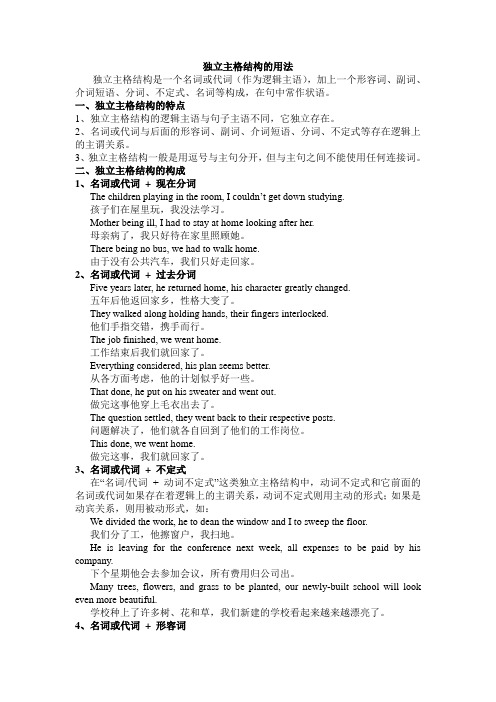
独立主格结构的用法独立主格结构是一个名词或代词(作为逻辑主语),加上一个形容词、副词、介词短语、分词、不定式、名词等构成,在句中常作状语。
一、独立主格结构的特点1、独立主格结构的逻辑主语与句子主语不同,它独立存在。
2、名词或代词与后面的形容词、副词、介词短语、分词、不定式等存在逻辑上的主谓关系。
3、独立主格结构一般是用逗号与主句分开,但与主句之间不能使用任何连接词。
二、独立主格结构的构成1、名词或代词+ 现在分词The children playing in the room, I couldn’t get down studying.孩子们在屋里玩,我没法学习。
Mother being ill, I had to stay at home looking after her.母亲病了,我只好待在家里照顾她。
There being no bus, we had to walk home.由于没有公共汽车,我们只好走回家。
2、名词或代词+ 过去分词Five years later, he returned home, his character greatly changed.五年后他返回家乡,性格大变了。
They walked along holding hands, their fingers interlocked.他们手指交错,携手而行。
The job finished, we went home.工作结束后我们就回家了。
Everything considered, his plan seems better.从各方面考虑,他的计划似乎好一些。
That done, he put on his sweater and went out.做完这事他穿上毛衣出去了。
The question settled, they went back to their respective posts.问题解决了,他们就各自回到了他们的工作岗位。
独立主格的用法

独立主格用法详解一、独立主格结构的形式英语中,独立主格结构的形式有两类:一类是:名词或代词跟形容词、副词、介词短语、非谓语动词连在一起,构成独立主格结构。
另一类是:介词with / without后接名词或代词再跟形容词、副词、介词短语、非谓语动词连在一起,构成独立主格结构。
A. 名词或代词+形容词、副词、介词短语、非谓语动词1.名词/ 代词+ 不定式。
如:A house to be built, we must save ev ery cent. 由于要建一座房子,我们必须节省每一分钱。
Now here is Li Lei, Wei Fang to co me tomorrow. 现在李蕾来了,魏方明天到。
2.名词/ 代词+ -ing分词。
如:The bus coming here soon, we should get everything ready. 汽车很快就要来了,我们应该把一切事情准备好。
Mother being ill, Li Lei was very wor ried. 母亲病了,李蕾非常焦急。
3.名词/ 代词+ 动词的过去分词。
如:His cup broken, he used his bowl inst ead. 茶杯破了,他就用碗来代替。
4.名词/ 代词+ 形容词。
如:The ground muddy, we should be care ful. 地面泞泥,我们应该小心。
5.名词/ 代词+ 副词。
如:The class over, we all went out to pl ay. 下课后,我们都出去玩。
6.名词/ 代词+ 介词短语。
Glasses in his hand, he asked where h is glasses were. 手里拿着眼镜,他问他的眼镜哪去了。
B. 介词with / without + 名词或代词+ 形容词、副词、介词短语、非谓语动词1.with / without + 名词或代词+ 形容词He spoke to us with his mouth full of food. 她口里含着食物跟我们说话。
英语的独立主格结构的用法

一、英语独立主格形成原因,其实是省略,为什么省略呢?省略目的就是将原来其实是两个句子,因为有了关系,比如因果,转折伴随等,才结合到了一起。
第二、尽管有些时候英语注重形合,但有了固定结构就流传了下来,大家都这么用,结果就这么用了。
二、英语独立主格结构和用法:(1)独立主结构形式可用以表时间,理由,条件,伴随状态等He lay on the grass, the sun shining upon him.= He lay on the grass, and the sun was shining upon him.Weather permitting, I'll start tomorrow.= If weather permits, I'll start tomorrow.School being over, the boys went home.= When school was over, the boys went home.The sun having set, we arrived at the station.= After the sun had set, we arrived at the station.王牌重点:当独立主格结构的主语表示“一般人”,如:we, one, you时,主语可省略,此用法常用于下列表达方式中:generally speaking 一般来说strictly speaking 严格地说talking of ... 谈到speaking of ... 说到judging from ... 由……来判断taking all things into consideration 把一切都考虑在内considering ... 考虑到……[示例]:If we judge from his face, he must be ill.= Judging from his face, he must be ill.He has lots of books if we consider that he is young.= He has lots of books, considering that he is young.(2)with 复合结构也是独立主格结构形式之一。
独立主格结构用法
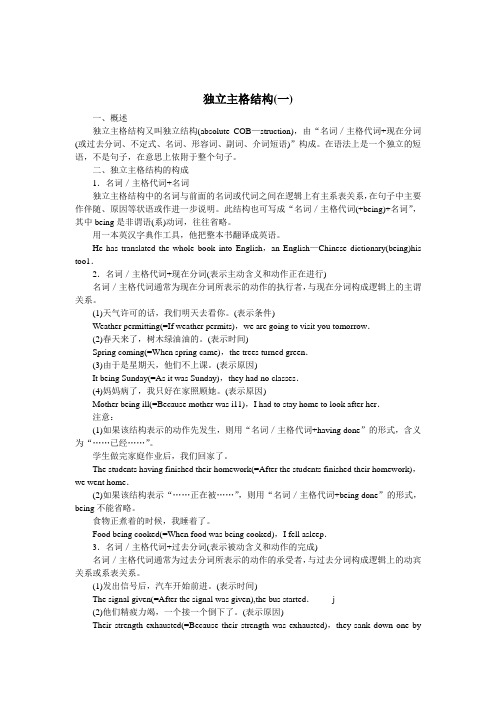
独立主格结构(一)一、概述独立主格结构又叫独立结构(absolute COB—struction),由“名词/主格代词+现在分词(或过去分词、不定式、名词、形容词、副词、介词短语)”构成。
在语法上是一个独立的短语,不是句子,在意思上依附于整个句子。
二、独立主格结构的构成1.名词/主格代词+名词独立主格结构中的名词与前面的名词或代词之间在逻辑上有主系表关系,在句子中主要作伴随、原因等状语或作进一步说明。
此结构也可写成“名词/主格代词(+being)+名词”,其中being是非谓语(系)动词,往往省略。
用一本英汉字典作工具,他把整本书翻译成英语。
He has translated the whole book into English,an English—Chinese dictionary(being)his too1.2.名词/主格代词+现在分词(表示主动含义和动作正在进行)名词/主格代词通常为现在分词所表示的动作的执行者,与现在分词构成逻辑上的主谓关系。
(1)天气许可的话,我们明天去看你。
(表示条件)Weather permitting(=If weather permits),we are going to visit you tomorrow.(2)春天来了,树木绿油油的。
(表示时间)Spring coming(=When spring came),the trees turned green.(3)由于是星期天,他们不上课。
(表示原因)It being Sunday(=As it was Sunday),they had no classes.(4)妈妈病了,我只好在家照顾她。
(表示原因)Mother being ill(=Because mother was i11),I had to stay home to look after her.注意:(1)如果该结构表示的动作先发生,则用“名词/主格代词+having done”的形式,含义为“……已经……”。
独立主格的用法

独立主格的用法1. 独立主格概述独立主格是一种语法结构,在句子中独立存在,不作为句子的主语或谓语的成分,用来表示伴随、原因、结果、条件等关系。
独立主格由一个名词或代词和一个动词的形式构成。
2. 独立主格的结构和用法独立主格的结构一般是“名词/代词 + 动词的形式”,其中动词的形式可以是动词的现在分词、过去分词或不定式等形式。
独立主格常常用在句子的开头或句子中,用来修饰整个句子或表示伴随或原因等关系。
2.1 作伴随状语独立主格可以用来表示动作的伴随或附带状况。
例如:•雨停了,天上的云彩散开了。
•大门打开了,孩子们欢呼着跑了进去。
2.2 表示原因独立主格可以表示句子的原因或解释。
例如:•天气太热了,他们都不愿意出去。
•车子坏了,他只好走路去上班。
2.3 表示结果独立主格还可以表示句子的结果或影响。
例如:•大家都努力学习,学校的成绩明显提高了。
•他很用功,最后考了第一名。
2.4 表示条件独立主格可以表示句子的条件或假设。
例如:•要是明天下雨,我们就不去郊游了。
•不用功,考试就会不及格。
3. 独立主格的使用注意事项3.1 独立性要求独立主格要能够独立存在于句子中,不与其他成分构成主谓关系。
例如:•雨停了,天上的云彩散开了。
(独立主格)•天上的云彩散开了,雨停了。
(不是独立主格)3.2 逗号隔开独立主格通常需要用逗号与句子其他成分隔开,以突出独立主格的作用。
例如:•如果不努力学习,成绩就会下降。
(独立主格)•如果不努力学习,成绩就会下降。
(不是独立主格)3.3 不同类型的独立主格根据独立主格所表示的关系,独立主格可以分为伴随状语、原因、结果和条件等类型,需要根据具体语境来确定所使用的独立主格类型。
4. 独立主格的例句为了更好地理解和掌握独立主格的用法,以下是一些例句:1.临走时,他向大家道别。
2.天气太冷了,他们都穿上了厚外套。
3.雪下得很大,学校里的人都在玩雪。
4.为了赶上最后一班车,他一个人跑着去了车站。
独立主格结构的用法与例句分析
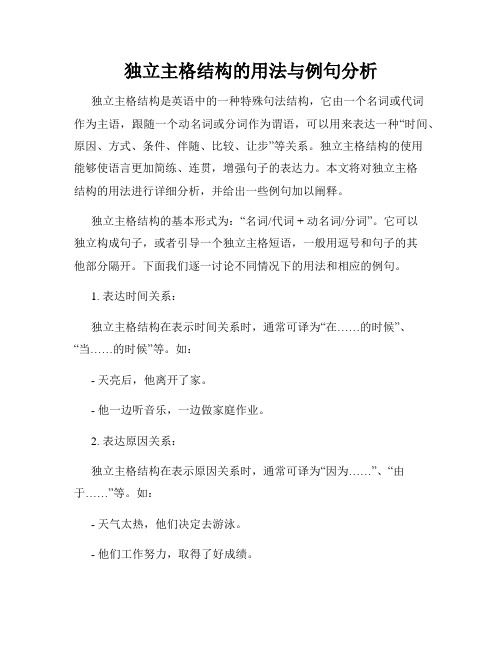
独立主格结构的用法与例句分析独立主格结构是英语中的一种特殊句法结构,它由一个名词或代词作为主语,跟随一个动名词或分词作为谓语,可以用来表达一种“时间、原因、方式、条件、伴随、比较、让步”等关系。
独立主格结构的使用能够使语言更加简练、连贯,增强句子的表达力。
本文将对独立主格结构的用法进行详细分析,并给出一些例句加以阐释。
独立主格结构的基本形式为:“名词/代词 + 动名词/分词”。
它可以独立构成句子,或者引导一个独立主格短语,一般用逗号和句子的其他部分隔开。
下面我们逐一讨论不同情况下的用法和相应的例句。
1. 表达时间关系:独立主格结构在表示时间关系时,通常可译为“在……的时候”、“当……的时候”等。
如:- 天亮后,他离开了家。
- 他一边听音乐,一边做家庭作业。
2. 表达原因关系:独立主格结构在表示原因关系时,通常可译为“因为……”、“由于……”等。
如:- 天气太热,他们决定去游泳。
- 他们工作努力,取得了好成绩。
3. 表达方式关系:独立主格结构在表示方式关系时,通常可译为“以……的方式”、“按照……的方法”等。
如:- 他闭着眼睛,唱起了那首歌。
- 孩子们手拉手,跳着舞。
4. 表达条件关系:独立主格结构在表示条件关系时,通常可译为“在……的情况下”、“如果……的话”等。
如:- 天气好的话,我们就去郊游。
- 花开时,蜜蜂才会飞舞。
5. 表达伴随关系:独立主格结构在表示伴随关系时,通常可译为“伴随着……”、“随着……的发展”等。
如:- 星星闪烁着,夜空变得更加美丽。
- 音乐声响起,观众们情绪高涨。
6. 表达比较关系:独立主格结构在表示比较关系时,通常可译为“和……相比”、“比起……来”等。
如:- 他那时非常胖,相比之下现在瘦了很多。
- 同学们都很聪明,他格外显得拙计。
7. 表达让步关系:独立主格结构在表示让步关系时,通常可译为“尽管……”、“虽然……”等。
如:- 虽然下雨了,但他还是去了打篮球。
- 尽管有困难,我仍然坚持着。
- 1、下载文档前请自行甄别文档内容的完整性,平台不提供额外的编辑、内容补充、找答案等附加服务。
- 2、"仅部分预览"的文档,不可在线预览部分如存在完整性等问题,可反馈申请退款(可完整预览的文档不适用该条件!)。
- 3、如文档侵犯您的权益,请联系客服反馈,我们会尽快为您处理(人工客服工作时间:9:00-18:30)。
独立主格结构的用法独立主格结构是一个名词或代词(作为逻辑主语),加上一个形容词、副词、介词短语、分词、不定式、名词等构成,在句中常作状语。
一、独立主格结构的特点1、独立主格结构的逻辑主语与句子主语不同,它独立存在。
2、名词或代词与后面的形容词、副词、介词短语、分词、不定式等存在逻辑上的主谓关系。
3、独立主格结构一般是用逗号与主句分开,但与主句之间不能使用任何连接词。
二、独立主格结构的构成1、名词或代词 + 现在分词The children playing in the room, Icoul dn’t get down studying.孩子们在屋里玩,我没法学习。
Mother being ill, I had to stay at home looking after her.母亲病了,我只好待在家里照顾她。
There being no bus, we had to walk home.由于没有公共汽车,我们只好走回家。
2、名词或代词 + 过去分词Five years later, he returned home, his character greatly changed.五年后他返回家乡,性格大变了。
They walked along holding hands, their fingers interlocked.他们手指交错,携手而行。
The job finished, we went home.工作结束后我们就回家了。
Everything considered, his plan seems better.从各方面考虑,他的计划似乎好一些。
That done, he put on his sweater and went out.做完这事他穿上毛衣出去了。
The question settled, they went back to their respective posts.问题解决了,他们就各自回到了他们的工作岗位。
This done, we went home.做完这事,我们就回家了。
3、名词或代词 + 不定式在“名词/代词 + 动词不定式”这类独立主格结构中,动词不定式和它前面的名词或代词如果存在着逻辑上的主谓关系,动词不定式则用主动的形式;如果是动宾关系,则用被动形式,如:We divided the work, he to dean the window and I to sweep the floor.我们分了工,他擦窗户,我扫地。
He is leaving for the conference next week, all expenses to be paid by his company.下个星期他会去参加会议,所有费用归公司出。
Many trees, flowers, and grass to be planted, our newly-built school will look even more beautiful.学校种上了许多树、花和草,我们新建的学校看起来越来越漂亮了。
4、名词或代词 + 形容词He entered the room, his face pale. 他走进屋来脸色苍白。
Computers very small, we can use them widely.电脑虽小,我们却能广泛地利用它们。
He sat in the front row, his mouth half open.他坐在前排,嘴半开着。
The Trojans asleep, the Greek soldiers crept out of the hollow wooden horse.特洛伊睡着了,于是希腊士兵从中空的木马里悄悄爬了出来。
5、名词或代词 + 副词在“名词或代词 + 副词”这类独立主格结构中,其中的副词主要是over, on, off, up, down等这类小品词,一般不用 -ly这类方式副词。
如:The meeting over, our headmaster soon left the meeting room.散会了,校长很快就离开了会议室。
The lights off, we could not go on with the work.灯熄了,我们不能继续工作了。
6、名词或代词 + 名词His first shot failure, he fired again.他第一枪没击中,又打了一枪。
Two hundred people died in the accident, many of them children.两百人死于事故,其中有许多小孩。
His book now a bestseller, he felt pleased with the world.他的书成了畅销书,他对一切都满意了。
7、名词或代词 + 介词短语He was waiting, his eyes on her back.他在等着,眼镜望着她的背影。
The soldiers dashed in, rifle in hand.士兵们端着枪冲了进来。
The old woman sat down, traces of tears still on her cheeks.老太太坐了下来,面颊上还带着泪痕。
We walked out, one behind the other.我们一个接一个地走了出来。
A girl came in, book in hand.一个少女进来了,手里拿着书。
三、独立主格结构的用法它表示谓语动词的发生时间、原因、条件或伴随情况等,相当于一个状语从句或并列句。
1、作时间状语The work done (= After the work had been done), we went home.This done, we went home.The question settled, we went home.My shoes removed, I entered a low-ceilinged room, treading cautiously on the soft tatami matting.2、作条件状语Weather permitting (= If weather permits), they will go on an outing to thebeach tomorrow.Weather permitting, we’ll have the match tomorrow.Other things being equal, I would buy the black dress not the white one.Such being the case, you have no grounds for dismissing him.3、作原因状语An important lecture to be given tomorrow (= As an important lecture will be given tomorrow), the professor has to stay up late into the night.明天将有一场重要的演讲要举行,讲师会熬夜到很晚。
All our savings gone, we started looking for jobs.积蓄全部用完了,我们就开始找工作。
The boy leading the way, we had no trouble finding the strange cave.经过这个男孩指路,我们很容易的就找到了那个奇怪的洞穴。
The monitor being ill, we’d better put the meeting off.班长病了,我们最好还是延期开会吧。
The river having risen in the night, the crossing was impossible.夜里河水上涨,渡河不可能了。
There being no further business to discuss, we all went home.没有别的事可讨论,我们都回家了。
4、作伴随状语He was lying on the grass, his hands crossed under his head. (= and his hands were crossed under his head)他躺在草地上,他的手圈起来放在头下。
Their room was on the third floor, its window overlooking the sports ground.他们的房间在三楼,房间的窗户可以俯瞰运动场。
He guiding her, they stumbled through the street.他印着她,两个人蹒跚地穿过那条街。
He died in 1892, his death being considered as a national calamity.他死于1892年,他的逝世被认为是举国的不幸。
5、表补充说明A hunter came in, his face red with cold. (= and his face was red with cold)注:独立主格结构表示时间、条件或原因时,相当于一个状语从句,一般放在句首,表示原因时还可以放在句末;表伴随状况或补充说明时,相当于一个并列句,通常放在句末。
四、使用独立主格结构注意事项1、独立主格与状语从句的转换当状语从句的主语与主句的主语不是指同一个对象时,可用独立主格结构取代状语从句,但不再保留连词。
如:After class was over (= Class being over/ Class over), the students soon left the classroom.2、不能省略being (having been)的情形在下列两种情况下,独立主格结构中的being(或having been)不能省略:(1)独立主格结构的逻辑主语是代词时。
如:It being Sunday, we went to church. 因为是星期天,我们去做了礼拜。
(2)在There being + 名词的结构中。
如:There being no bus, we had to go home on foot.因为没有公共汽车,所以我们不得不步行回家。
3、通常不用物主代词或冠词在“名词(或代词) + 介词短语”构成的独立主格结构中,一般不用形容词性物主代词和冠词。
